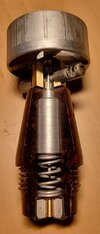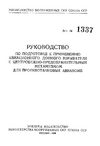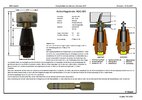British Ordnance Collectors Network
You are using an out of date browser. It may not display this or other websites correctly.
You should upgrade or use an alternative browser.
You should upgrade or use an alternative browser.
Russian bomb fuze
- Thread starter pzgr40
- Start date
Eggburt1969
Well-Known Member
As far as I'm aware it is designated ADTs (АДЦ)? Maybe it's a transliteration thing, I've seen lots of such errors.
The front cover of a 1949 manual I have for the fuze is attached.
АДЦ (Авиационного Донного взрывателя с Центробежно-предохранительным механизмом) = ADTs (Aviatsionnogo Donnogo vzryvatelya s Tsentrobezhno-predokhranitel'nym mekhanizmom) = aviation base fuze with centrifugal safety mechanism
The front cover of a 1949 manual I have for the fuze is attached.
АДЦ (Авиационного Донного взрывателя с Центробежно-предохранительным механизмом) = ADTs (Aviatsionnogo Donnogo vzryvatelya s Tsentrobezhno-predokhranitel'nym mekhanizmom) = aviation base fuze with centrifugal safety mechanism
Attachments
The fuse for ww2 period PTAB-2.5-1.5 (ПТАБ-2,5-1,5) and PTAB 10-2.5 (ПТАБ-10-2,5) was the AD-A (АД-А)
(D indicates a bottom fuse).
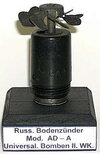
The AD-C (АД-Ц) was a variant that instead of being a bottom fuse with a detonator cap as teh AD-A, was a bottom centrifugal fuse with a detonator cap
(The cap is a pin-type detonator).
" The PTAB-2.5-1.5 anti-tank bombs were loaded with the bottom pointing down. At the same time, the fuse body was also used to attach the PTAB stabilizer to the ammunition. The fuse provided instantaneous action. The vast majority of AD-A were made in metal cases, although they are very rare. analogues with plastic ones,
the safety mechanism consisted of a 6-bladed impeller (its screw was returned to the firing pin and held it), a U-shaped safety pin that fixed the impeller and ensured the safety of the fuse during service, as well as a safety spring that held the tip of the firing pin in direct contact. proximity to the detonator capsule after folding the impeller.
Before placing PTAB-2.5-1.5 in the bomb bays of attack aircraft or cassette bombers Pe-2, Tu-2, Yak-9B, etc., the cylindrical ammunition stabilizer was covered with a lid with P- figurative safety pin. After the PTAB was released by the incoming air flow, this cover was dropped, the impeller began to rotate and, after a certain number of revolutions, it separated along with the cap, releasing the firing pin and arming the fuse. When a PTAB hits a target, the inertial striker moves and, compressing the safety spring, pierces the detonator capsule with its sting. The explosive impulse was initiated by the intermediate detonator and then by the loading of the ammunition.
The disadvantages of the AD-A fuse included the unsatisfactory design of the safety mechanism, since there were cases of explosions of PTABs in their final equipped form when transporting them to the airfield. The reason was the turning of the impeller several revolutions, which resulted in the formation of a backlash in the striker. sufficient to pierce the igniter primer with a sting. In addition, the AD-A “sinned” by having too short a cocking time due to the rapid collapse of the impeller. The result of this was the detonation of air bombs near the aircraft after they were dropped in one gulp. In this case, the contact fuses were triggered as a result of a collision between neighboring PTABs or their sharp braking by incoming air flows.
In addition, the rough processing of the fuse parts using simplified wartime technologies and large backlashes in the impeller screw often led to jamming of the impeller itself. The same effect also appeared as a result of the blades touching the PTAB stabilizer box, which was deformed or not installed coaxially with the body of the bomb. And due to the deformation of the safety spring, the sting of the firing pin was deflected to the side, bypassing the igniter capsule.... ""
However your photograph seem sto refer to the fuse of the Bielorussian produced modern version of the PTAB - the PTAB-2.5 MB1/2 (ПТАБ-2,5 МБ1 and ПТАБ-2,5 МБ2) and the PTAB 10-5. They are the ones used in modern disposable bomb clusters such as the RBK-500-225 PTAB-2.5, though they are currently being adapted to be dropped by drones. The information published by the manufacturer speaks of "contact fuze" without giving it a specific name HOWEVER the photograph of the MB1 allows to see the inscrition on the fuze: АД-Ц - so it si indeed as Eggburt196 and sgdbdr have indicated.
Other versions such as the PTAB-2.5M (ПТАБ-2,5М) are also produced by Russia an used in the battefields of Ukraine and Syria
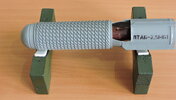
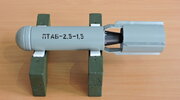
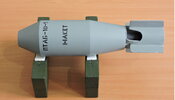
ПТАБ-2,5М:
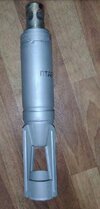
(D indicates a bottom fuse).

The AD-C (АД-Ц) was a variant that instead of being a bottom fuse with a detonator cap as teh AD-A, was a bottom centrifugal fuse with a detonator cap
(The cap is a pin-type detonator).
" The PTAB-2.5-1.5 anti-tank bombs were loaded with the bottom pointing down. At the same time, the fuse body was also used to attach the PTAB stabilizer to the ammunition. The fuse provided instantaneous action. The vast majority of AD-A were made in metal cases, although they are very rare. analogues with plastic ones,
the safety mechanism consisted of a 6-bladed impeller (its screw was returned to the firing pin and held it), a U-shaped safety pin that fixed the impeller and ensured the safety of the fuse during service, as well as a safety spring that held the tip of the firing pin in direct contact. proximity to the detonator capsule after folding the impeller.
Before placing PTAB-2.5-1.5 in the bomb bays of attack aircraft or cassette bombers Pe-2, Tu-2, Yak-9B, etc., the cylindrical ammunition stabilizer was covered with a lid with P- figurative safety pin. After the PTAB was released by the incoming air flow, this cover was dropped, the impeller began to rotate and, after a certain number of revolutions, it separated along with the cap, releasing the firing pin and arming the fuse. When a PTAB hits a target, the inertial striker moves and, compressing the safety spring, pierces the detonator capsule with its sting. The explosive impulse was initiated by the intermediate detonator and then by the loading of the ammunition.
The disadvantages of the AD-A fuse included the unsatisfactory design of the safety mechanism, since there were cases of explosions of PTABs in their final equipped form when transporting them to the airfield. The reason was the turning of the impeller several revolutions, which resulted in the formation of a backlash in the striker. sufficient to pierce the igniter primer with a sting. In addition, the AD-A “sinned” by having too short a cocking time due to the rapid collapse of the impeller. The result of this was the detonation of air bombs near the aircraft after they were dropped in one gulp. In this case, the contact fuses were triggered as a result of a collision between neighboring PTABs or their sharp braking by incoming air flows.
In addition, the rough processing of the fuse parts using simplified wartime technologies and large backlashes in the impeller screw often led to jamming of the impeller itself. The same effect also appeared as a result of the blades touching the PTAB stabilizer box, which was deformed or not installed coaxially with the body of the bomb. And due to the deformation of the safety spring, the sting of the firing pin was deflected to the side, bypassing the igniter capsule.... ""
However your photograph seem sto refer to the fuse of the Bielorussian produced modern version of the PTAB - the PTAB-2.5 MB1/2 (ПТАБ-2,5 МБ1 and ПТАБ-2,5 МБ2) and the PTAB 10-5. They are the ones used in modern disposable bomb clusters such as the RBK-500-225 PTAB-2.5, though they are currently being adapted to be dropped by drones. The information published by the manufacturer speaks of "contact fuze" without giving it a specific name HOWEVER the photograph of the MB1 allows to see the inscrition on the fuze: АД-Ц - so it si indeed as Eggburt196 and sgdbdr have indicated.
Other versions such as the PTAB-2.5M (ПТАБ-2,5М) are also produced by Russia an used in the battefields of Ukraine and Syria



ПТАБ-2,5М:

Eggburt1969
Well-Known Member
As to the ADTs or ADC transliteration of the Russian Cyrillic АДЦ; PS there's no hyphen in the Russian designation. It all depends on what transliteration system you use. I use the BGN/PCGN transliteration standard, which I found to be the most commonly used in English (Western) reference material. Use whichever you feel a preference to, as there are plenty to choose from (see link below).

 en.wikipedia.org
en.wikipedia.org
Just for note the Russian 1949 manual states the ADTs (BGN/PCGN transliteration standard) can be used with the 1945 versions of the PTAB-2.5-1.5 (ПТАБ-2,5-1,5) and PTAB-10-2.5 (ПТАБ-10-2,5). It does also mention the AD-A (a hyphen is present in this designation), but only as follows "ADTs fuzes are safer to use than AD-A fuzes, when working with these fuzes it is necessary to follow general safety rules, namely" (it continues after this with the things that should not, and must be, done).
For the 'modern' PTAB-2.5 (ПТАБ-2,5) bomb/submunition, as part of the RBK-500-225 (РБК-500-225) c, the latter's manual states that the ADTs is used. For the 'modern' PTAB-10-5 (ПТАБ-10-5) bomb/submunition, as part of the RBK-500-225 bomb/submunition, the manual states the PDTs (ПДЦ) fuze is used.

Romanization of Russian - Wikipedia
Just for note the Russian 1949 manual states the ADTs (BGN/PCGN transliteration standard) can be used with the 1945 versions of the PTAB-2.5-1.5 (ПТАБ-2,5-1,5) and PTAB-10-2.5 (ПТАБ-10-2,5). It does also mention the AD-A (a hyphen is present in this designation), but only as follows "ADTs fuzes are safer to use than AD-A fuzes, when working with these fuzes it is necessary to follow general safety rules, namely" (it continues after this with the things that should not, and must be, done).
For the 'modern' PTAB-2.5 (ПТАБ-2,5) bomb/submunition, as part of the RBK-500-225 (РБК-500-225) c, the latter's manual states that the ADTs is used. For the 'modern' PTAB-10-5 (ПТАБ-10-5) bomb/submunition, as part of the RBK-500-225 bomb/submunition, the manual states the PDTs (ПДЦ) fuze is used.
Last edited:
microplastic
Well-Known Member
I have the same problem, i can't upload, because of the size. But the .pdf document was only 17MB in size...Some time ago I added origial soviet manual for fuze АДЦ and it was available (as I notice) in my profile, but it is not available right now. Probably because of the size of PDF document. Unfortunately I can`t make it smaller.
My file is much smaller, but also will search way how to add it to BOCN`s downloads.I have the same problem, i can't upload, because of the size. But the .pdf document was only 17MB in size...

